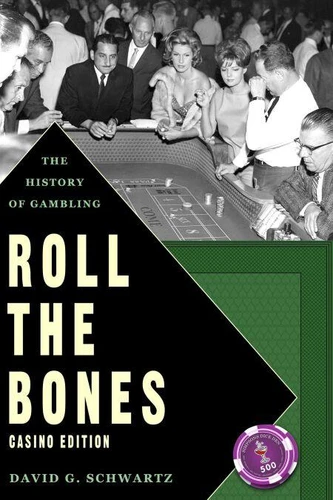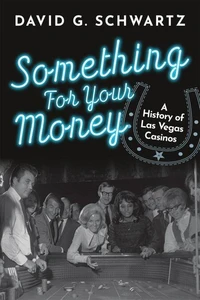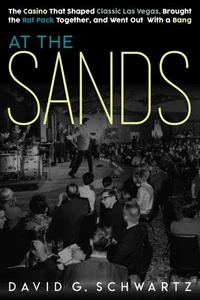Roll the Bones: The History of Gambling
Par :Formats :
Disponible dans votre compte client Decitre ou Furet du Nord dès validation de votre commande. Le format ePub est :
- Compatible avec une lecture sur My Vivlio (smartphone, tablette, ordinateur)
- Compatible avec une lecture sur liseuses Vivlio
- Pour les liseuses autres que Vivlio, vous devez utiliser le logiciel Adobe Digital Edition. Non compatible avec la lecture sur les liseuses Kindle, Remarkable et Sony
 , qui est-ce ?
, qui est-ce ?Notre partenaire de plateforme de lecture numérique où vous retrouverez l'ensemble de vos ebooks gratuitement
Pour en savoir plus sur nos ebooks, consultez notre aide en ligne ici
- FormatePub
- ISBN978-1-939546-01-2
- EAN9781939546012
- Date de parution28/07/2020
- Protection num.pas de protection
- Infos supplémentairesepub
- ÉditeurDavid Schwartz
Résumé
Roll the Bones tells the story of gambling: where it came from, how it has changed, and where it is now. This is the new Casino Edition. which updates and expands the global history of gambling to include a greater focus on casinos, from their development in European spas to their growth in Reno and Las Vegas. New material chronicles in greater depth the development of casino resorts on the Las Vegas Strip and their spread throughout the United States.
A new chapter better places Atlantic City's casinos into their correct context, and new material accounts for the rise of casinos in Asia and online gaming. From the first modern casino in Venice (1638), casinos have grown incredibly. During the 18th and 19th century, a series of European spa towns, culminating in Monte Carlo, hosted casinos. In the United States, during those same years, gambling developed both in illegal urban gambling halls and in the wide-open saloons of the western frontier.
Those two strands of American gambling came together in Nevada's legal casinos, whose current regime dates from 1931. Developing with a healthy assist from elements affiliated with organized crime, these casinos eventually outgrew their rough-hewn routes, becoming sun-drenched pleasure palaces along the Las Vegas Strip. With Nevada casinos proving successful, other states, beginning with New Jersey in 1976, rolled the dice.
From there, casinos have come to America's tribal lands, rivers, and urban centers. In the last decade, gambling has moved online, while Asia-with multi-billion dollar projects in Macau and Singapore-has become a new casino frontier. Reading Roll the Bones, you'll get a better appreciation for how long casinos and gambling have been with us-and what they mean to us today.
A new chapter better places Atlantic City's casinos into their correct context, and new material accounts for the rise of casinos in Asia and online gaming. From the first modern casino in Venice (1638), casinos have grown incredibly. During the 18th and 19th century, a series of European spa towns, culminating in Monte Carlo, hosted casinos. In the United States, during those same years, gambling developed both in illegal urban gambling halls and in the wide-open saloons of the western frontier.
Those two strands of American gambling came together in Nevada's legal casinos, whose current regime dates from 1931. Developing with a healthy assist from elements affiliated with organized crime, these casinos eventually outgrew their rough-hewn routes, becoming sun-drenched pleasure palaces along the Las Vegas Strip. With Nevada casinos proving successful, other states, beginning with New Jersey in 1976, rolled the dice.
From there, casinos have come to America's tribal lands, rivers, and urban centers. In the last decade, gambling has moved online, while Asia-with multi-billion dollar projects in Macau and Singapore-has become a new casino frontier. Reading Roll the Bones, you'll get a better appreciation for how long casinos and gambling have been with us-and what they mean to us today.
Roll the Bones tells the story of gambling: where it came from, how it has changed, and where it is now. This is the new Casino Edition. which updates and expands the global history of gambling to include a greater focus on casinos, from their development in European spas to their growth in Reno and Las Vegas. New material chronicles in greater depth the development of casino resorts on the Las Vegas Strip and their spread throughout the United States.
A new chapter better places Atlantic City's casinos into their correct context, and new material accounts for the rise of casinos in Asia and online gaming. From the first modern casino in Venice (1638), casinos have grown incredibly. During the 18th and 19th century, a series of European spa towns, culminating in Monte Carlo, hosted casinos. In the United States, during those same years, gambling developed both in illegal urban gambling halls and in the wide-open saloons of the western frontier.
Those two strands of American gambling came together in Nevada's legal casinos, whose current regime dates from 1931. Developing with a healthy assist from elements affiliated with organized crime, these casinos eventually outgrew their rough-hewn routes, becoming sun-drenched pleasure palaces along the Las Vegas Strip. With Nevada casinos proving successful, other states, beginning with New Jersey in 1976, rolled the dice.
From there, casinos have come to America's tribal lands, rivers, and urban centers. In the last decade, gambling has moved online, while Asia-with multi-billion dollar projects in Macau and Singapore-has become a new casino frontier. Reading Roll the Bones, you'll get a better appreciation for how long casinos and gambling have been with us-and what they mean to us today.
A new chapter better places Atlantic City's casinos into their correct context, and new material accounts for the rise of casinos in Asia and online gaming. From the first modern casino in Venice (1638), casinos have grown incredibly. During the 18th and 19th century, a series of European spa towns, culminating in Monte Carlo, hosted casinos. In the United States, during those same years, gambling developed both in illegal urban gambling halls and in the wide-open saloons of the western frontier.
Those two strands of American gambling came together in Nevada's legal casinos, whose current regime dates from 1931. Developing with a healthy assist from elements affiliated with organized crime, these casinos eventually outgrew their rough-hewn routes, becoming sun-drenched pleasure palaces along the Las Vegas Strip. With Nevada casinos proving successful, other states, beginning with New Jersey in 1976, rolled the dice.
From there, casinos have come to America's tribal lands, rivers, and urban centers. In the last decade, gambling has moved online, while Asia-with multi-billion dollar projects in Macau and Singapore-has become a new casino frontier. Reading Roll the Bones, you'll get a better appreciation for how long casinos and gambling have been with us-and what they mean to us today.






